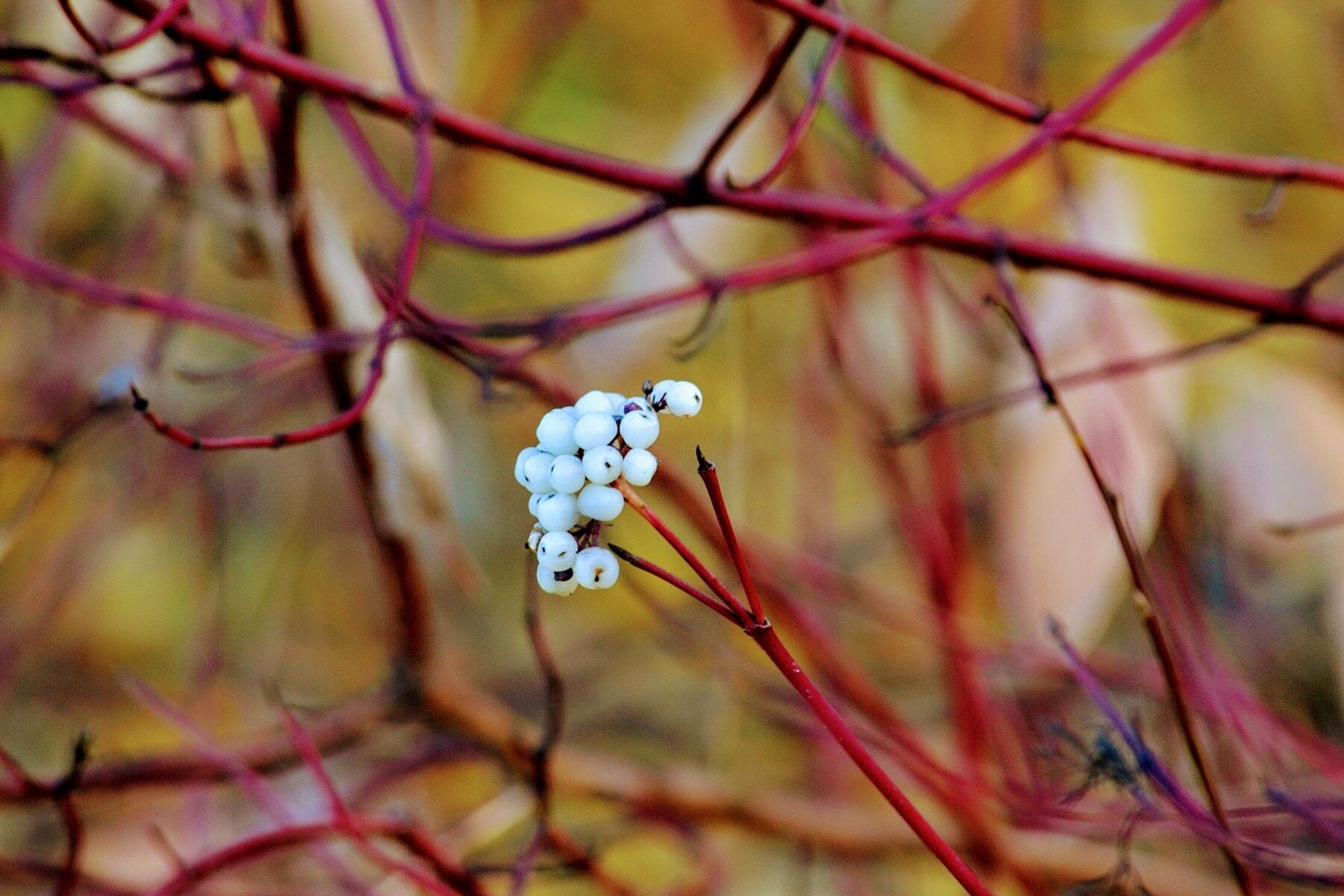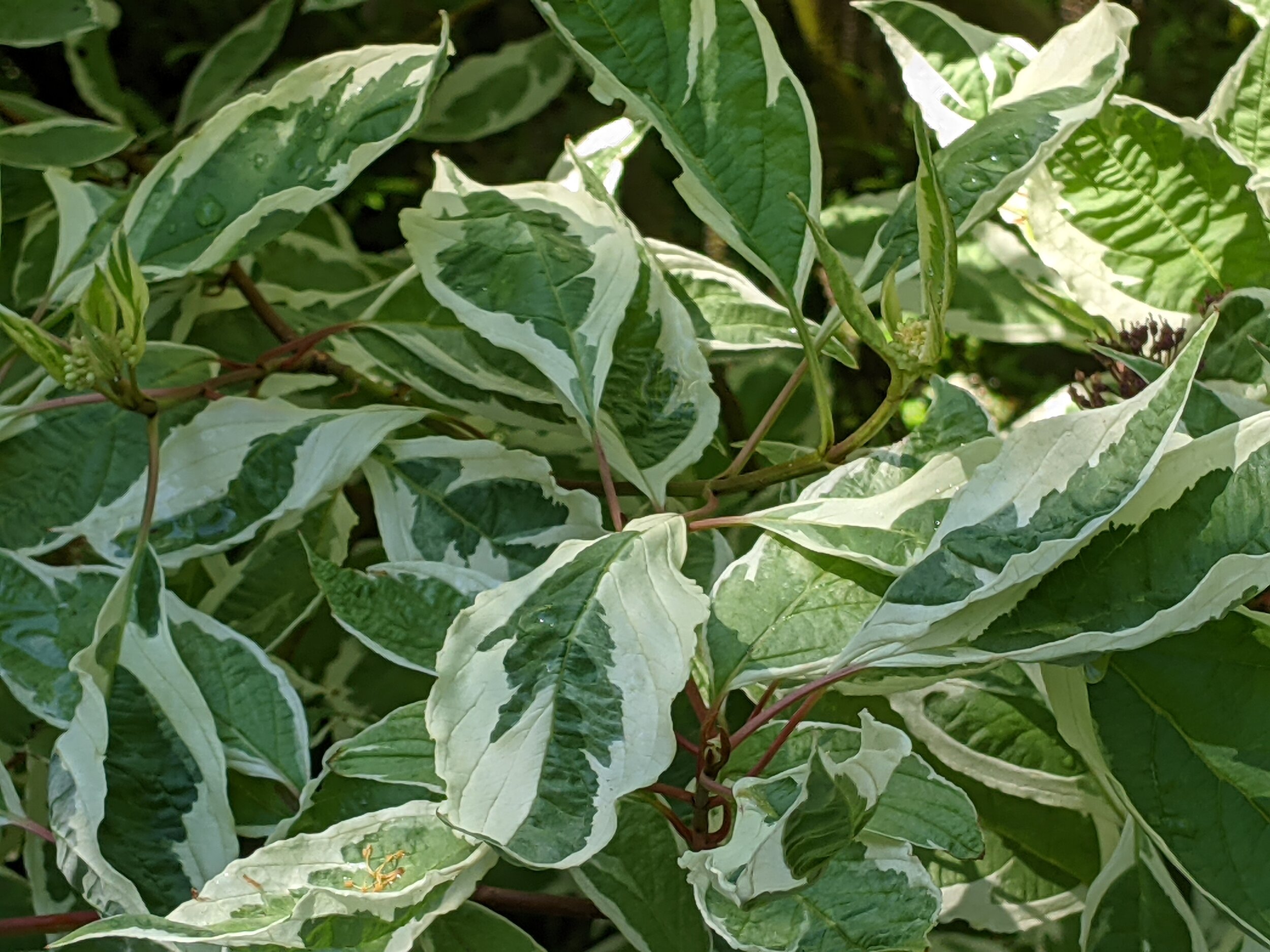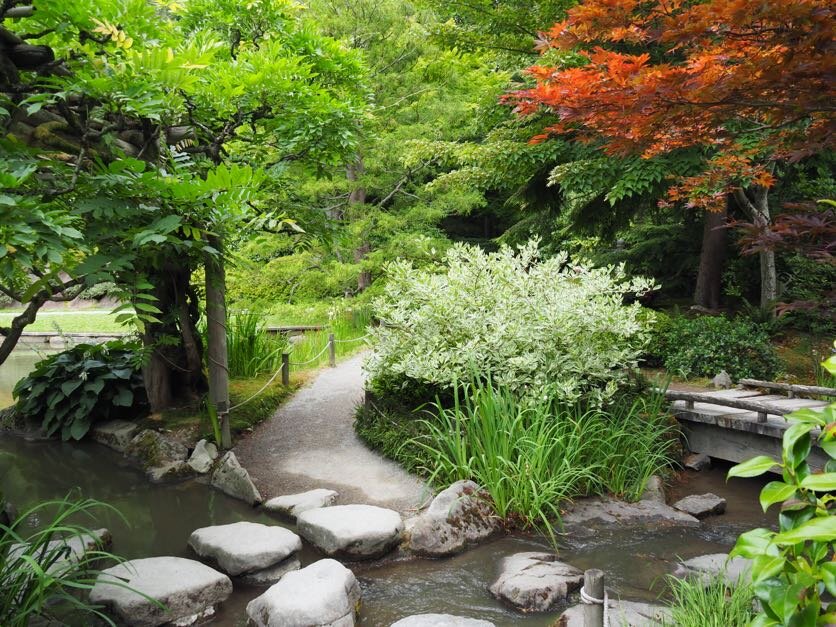Cornus alba ‘Argenteo-marginata’ is a Shrub for All Seasons
By Corinne Kennedy
Variegated tatarian dogwood in the Seattle Japanese Garden. (photo: Corinne Kennedy)
The Seattle Japanese Garden is lovely in spring, with many trees and shrubs in full, glorious bloom. In late spring and summer, though, visitors are drawn to the subtle beauty of its many shades of green. Now the shrub dogwood Cornus alba ‘Argenteo-marginata’ draws our attention. Though it lacks the showy flowering of the tree dogwoods, its gray-green leaves edged in white are a luminous presence that lasts throughout the summer. A single specimen is planted near the Wisteria arbor, where the pond’s water flows out of the Garden.
Most often known as tatarian dogwood, Cornus alba[1] is a deciduous shrub native to northern China, northern Korea, and Siberia. Like many other shrub dogwoods—some known as red-twig dogwoods—it’s notable for the winter brilliance of its showy red stems. (“Tatarian” is derived from the word Tatar, also spelled Tartar, the name of nomadic tribes that inhabited central Asia beginning in the 5th century.) Other common names are Siberian dogwood and red-barked dogwood. Our Garden’s variegated cultivar, unlike green-leaved forms, is lovely in all seasons. Spring and summer leaves are brightly elegant, and autumn foliage a subtle blend of apricot and rose. After leaves have dropped, the color of its stems deepens to a fiery scarlet-red.
[1] Because of its close resemblance to the Pacific Northwest native, Cornus sericea, tatarian dogwood is now classified as Cornus sericea subsp. sericea, but most nurseries continue to list it as Cornus alba.
White berries and brilliant red winter stems of Cornus alba, named for the color of its berries. (photo: Joanna Boisse, Wikimedia Commons)
The genus name, Cornus, derives from the Latin word, cornu, meaning horn, and probably refers to the extremely hard wood of many Cornus species. The word Cornus itself is Latin for a particular species, Cornus mas, known as cornelian cherry. The species name of our Garden’s shrub (alba) means white, a reference to its white berries.
The origin of the common name “dogwood” is unclear. Many cultures have explanatory stories, but they likely reveal cultural values, not historical facts . The most probable explanation is that dogwood derives from “dagwood”—a reference to the Old English word “dag,” meaning “dagger” or “skewer,” implements made of hard, dense wood.
Cornus alba ‘Argenteo-marginata’ has shimmering gray-green leaves with irregular white margins. (photo: Corinne Kennedy)
Our Garden’s cultivar was planted in 1999. It was received as Cornus alba ‘Argenteo-marginata,’ likely identical to Cornus alba ‘Elegantissima,’ the cultivar name now most often in use. A fast-growing, multi-stemmed deciduous shrub, it is less vigorous than the species plant, Cornus alba, maturing to about ten feet tall and wide. With annual pruning, though, it can be kept to a more manageable size, about six feet tall by five feet wide.
The subtly elegant leaves of variegated tatarian dogwood are gray-green with irregular white margins, remaining brightly attractive throughout the summer months. Creamy white spring flowers are held in flat clusters, and often continue to open intermittently into early summer. Though not considered showy, they’re a pleasing color echo of the white-edged foliage. Berry-like white fruits, tinged bluish-green, ripen in mid-summer, and are attractive to birds. Botanically, they are classified as drupes, fruits with a central stone containing the seed.) Fall color is a lovely blend of gold, apricot and rose, and winter stems are brilliant scarlet-red.
Creamy white flower cluster of Cornus alba ‘Argenteo-marginata.’ (photo: Chie Iida)
Cornus alba ‘Argenteo-marginata’ is hardy to USDA Zone 3 (minimum temperature -40 to -30 degrees Fahrenheit). It grows best in organically rich, moist, well-drained soil, but is adaptable to soils of various types and pH. Plants perform well in full sun or light shade, with sunny areas promoting the best winter stem color. Though tolerant of urban pollution, dry soils, and occasional standing water once established, they should not be planted in hot-summer areas. During our region’s dry summers, regular watering is needed. Stressed plants, unfortunately, are susceptible to various insect and disease problems.
Like several other shrub dogwood species, Cornus alba and its cultivars are prone to suckering, sending up multiple stems from the base. This colonization can be controlled by removing suckers and by “root-pruning,” using a spade to cut a circle around the plant, thus containing roots and stems. Regular pruning in early spring is needed both to control shrub size and to maintain the brilliant color of young stems. One strategy is to cut back about a third of the oldest stems to six inches every year. An alternative is to renew plants by pruning all stems to about eight inches every two or three years.
As a multi-stemmed shrub dogwood, Cornus alba is useful for erosion control on slopes and along shorelines. Branches provide shelter for wildlife, flowers supply nectar to pollinating insects, and fruits are attractive to birds and mammals. Buds, twigs, and leaves are sometimes eaten, but damage is usually not serious.
Cornus alba ‘Argenteo-marginata’ near the Wisteria arbor in the Seattle Japanese Garden (photo: Chie Iida)
Green-leaved forms of red-stemmed shrub dogwoods are often planted in odd-numbered groupings or as informal hedges, but I believe that Cornus alba ‘Argenteo-marginata’ is best used as a focal point plant. It is particularly effective as a single specimen within a mixed border—as in the Seattle Japanese Garden. We’re drawn to its luminous two-toned foliage and relatively large presence; wherever planted, it’s an attractive and useful addition to the garden. Throughout the seasons, it provides shelter and food for wild creatures, serves as an effective contrast to other plants, and gives pleasure to those of us who love gardens.
Corinne Kennedy is a Garden Guide, frequent contributor to the Seattle Japanese Garden blog, and retired garden designer.





